Art News and Updates from Gallereo
All the latest news from the art world, as well as what's happening here at Gallereo. If you've built a gallery at Gallereo, let us know about your experience and you and your site could feature in our blog in the coming weeks.
Friday 13th June 2014Auction House Competition
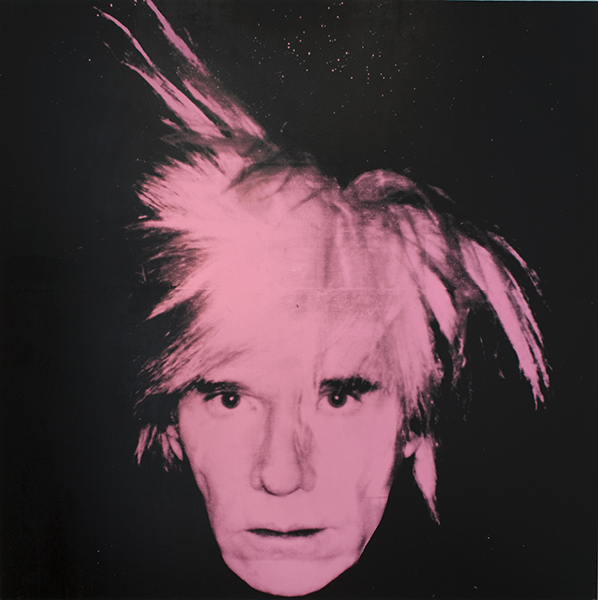
The art world is famous for price tags as lofty as the masterpieces they represent. Staggering prices are commanded every time a famous work changes hands, and even the members of the public who aren't the target market are fascinated by the eye-popping sums. In the past, however, this type of big ticket sale has always been the province of the auction house; the Sotheby's, the Christie's, and occasionally a private sale brokered by a top-tier gallery. However, at the latest art fair in Basel (which we discussed previously in our post about the best cities for art lovers), an incredible challenge to the supremacy of the auction house has appeared.
New York is unquestionably the American centre for art auctions (and arguably the world centre as well, though doubtless many in London would disagree), and during May of this year, $2.2 billion USD worth of art sales took place during the course of two weeks. Unquestionably an impressive figure, but the Art Basel fair that just finished up recently featured 285 galleries and dealers selling a whopping $4 billion USD worth of art. In fact, on the very first day of the fair alone, over $55 million dollars worth of sales had been made - by only 11 galleries.
A piece by Jeff Koons, the subject of one of our recent artist spotlights, was sold for $5 million, but the true sales crown belonged to a famous piece by famed Pop Art paragon Andy Warhol, a pink-tinted self-portrait of the artist wearing his infamously iconic fright wig which sold for a whopping $32 million USD, which equals the record price ever achieved at an auction house for a Warhol self-portrait.
So what does this really mean for the auction house world paradigm? In the long run, probably not a great deal. Art sales are a very unique type of commerce, and the auction house is unlikely to be completely replaced by the art fair, but it will definitely have to step aside to make room. There is little doubt that the snobbery traditionally associated with the auction house will push some away, but at the same time, it provides a different experience to the mad rush of the art fair. Even though digital downloads essentially killed the record store, a comparable situation isn't likely to occur in the art world. Art fairs and auction houses may be selling the same calibre of piece, but the experiences they offer are sufficiently different - and the demand for artwork so voracious - that they will likely co-exist for a long time to come yet.
Posted on June 13th 2014 on 05:05pm
0 Comments
Wednesday 11th June 2014Summer Art Inspiration

If there's one thing I've learned over the course of my artistic career, it's that art doesn't happen in a vacuum. That's not to say that art can't happen in space - Commander Hadfield's rendition of David Bowie's Space Oddity on the International Space Station leaps to mind - but rather that the kind of ideas and inspiration that drive your creativity and artistic thinking don't happen in a vacuum. In order to function at your full creative potential, you need a great deal of new input, whether it's new ideas that you've gotten from casual conversations with friends or a new exhibit that inspired you to test out some new techniques or anything in between. Exposure to the world is what makes us want to create.
The winter months are perfect for studio time (although they can be just as creatively inspiring in and of themselves, with the right mindset), as the cold weather tends to keep us all indoors. Summer, however, tends to have the opposite effect in the artistically inclined, and both beautiful bright sunshine and powerful dark thunderstorms can be powerful inspirations. The most important thing about summer, though, is that it gets us back out into the world, coming into contact with life and society in a way that tends not to happen as much in the winter. When the entire world seems wrapped in scarves and gloves, freezing and covered in slush, it seems to evoke a sense of internalization and introspection. Summer, of course, is a time for showing skin to the sky and the suddenly the world is open and extroverted and curious again.
If you find yourself with a creative block sometime in the next few months (sorry to any readers who are in the southern hemisphere, about to enter the dead of winter), take the time to go outside and do something you wouldn't normally do. Summer basically begs you to enjoy it, so get out of the studio and go expand your horizons in the world. You might be amazed at the kind of creative boosts a simple stroll can have, whether for simply relaxing you and allowing you to refocus on the project at hand or because you see or do something new and inspiring to you.
Go out there - live life, and the art will follow. Sorry digital artists, this means you too! Pry yourself away from the screen and get some sunshine!
Posted on June 11th 2014 on 03:05pm
0 Comments
Friday 06th June 2014Crowdfunding Galleries

Unless you've been living on the Moon for the last few years, you've probably run across the term 'crowdfunding'. If you haven't heard of it before, the concept is actually extremely simple, albeit incredibly powerful. It uses a 'pay-what-you-can' model distributed over a large number of potential customers to acquire funding for projects. There are often various tiers of contributors, so that those who contribute more to a project get more out of it than those who make the minimum contribution.
For example, say you want to make a documentary, but need money for development costs and have no film studio contacts or capital. Posting your plan on a crowdfunding site, you would entice people to contribute to your documentary project. People who contribute $5 get a mention in the film credits, people who contribute $20 get a copy of the film and a credit mention, people who contribute $40 get an additional 'Making Of' documentary, the film itself, and a credit mention, etc. Once your goal is reached, the money is released and you can begin to work on your film.
The most popular crowdfunding sites like Kickstarter and Indiegogo are enabling entirely new revenue models across the creative sphere, from video game development to documentary filmmaking to industrial engineering. But at long last, the crowdfunding model has reached into the gallery world - at least, in the United Kingdom.
A new project entitled Art Happens has been launched by the charity Art Fund, in an attempt to bring the incredible power of crowdfunding to the UK art world. Five galleries so far have launched projects using the Art Happens platform: St. Fagan's National History Museum in Cardiff, the Bowes Museum in County Durham, Compton Verney in Warwickshire, the Museum of the Gorge in Shropshire, and the Jerwood Gallery in East Sussex. At the moment, the most popular project is only 12% funded, with 18 contributors and 74 days left to reach the fundraising goal. This, quite naturally, begs the question of whether or not the initial selections are interesting enough for those who follow the tech-centric crowdfunding payment model, or whether the project simply has yet to go viral, which everyone appreciates is an incredibly difficult thing to predict.
With luck, the Art Happens project will trigger other galleries and artists to begin to explore new methods of financing their projects - after all, nobody really wants to be too much of a starving artist!
Posted on June 06th 2014 on 02:59pm
0 Comments
Wednesday 04th June 2014The Hidden Works
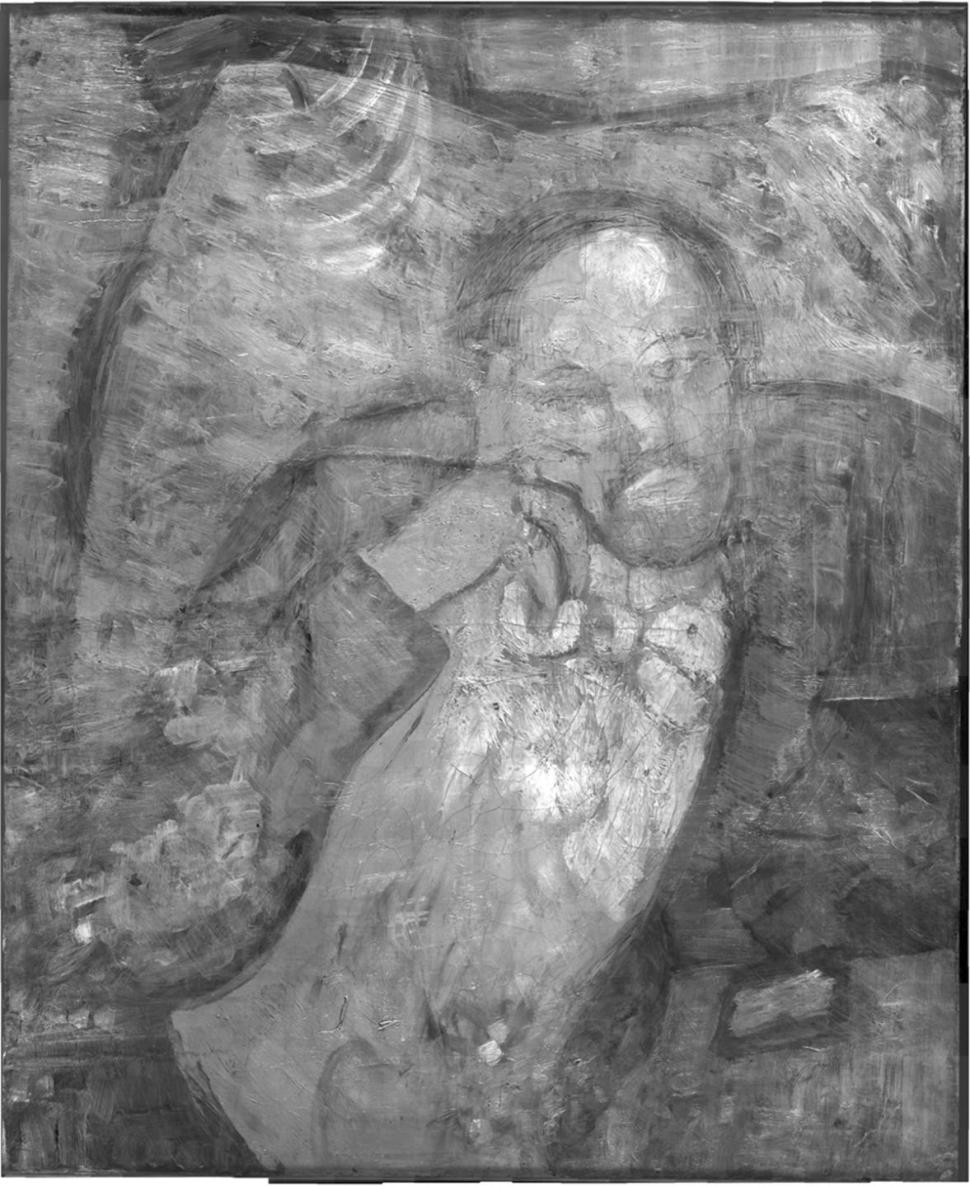
If you're a painter, you might have been here before: you're working on a canvas, nearly finished executing your vision, and suddenly you get frustrated and decide to scrap the project. Or maybe you've suddenly come up with a brilliant painting but you're all out of prepped canvases, and you need to start work immediately to preserve the clarity of your idea. Whatever the reason, the only way to get yourself a new working space is to paint over something you've already done. It's probably happened to you at least once in your artistic career, and if not, then you should consider yourself lucky! But what happens when you turn out to be one of the most famous painters of the previous century? Gallery and museums will bring out the forensic toolkit!
This is exactly what happened recently with one of the first well-known pieces by Pablo Picasso, the patron saint of Cubism, one of the most famous artists from the 20th century. One of his first pieces to be considered a masterpiece, the 1901 painting 'The Blue Room' signalled the beginning of his famous (to Picasso fans, at least) 'Blue Period', a 3 year stretch marked by a certain melancholia. Art experts had long been puzzled by some inconsistencies in the brush strokes found in the painting, strokes that didn't match what the surface painting appeared to show. As far back as 1954, one expert had noticed these discrepancies, but it wasn't until the mid 1990s that the art world got around to bringing in some sophisticated technology - the X-ray.
Not typically used on paintings, x-rays of 'The Blue Room' showed that there was indeed something painted beneath the surface, although x-rays weren't sufficient to provide a clear image of what, if anything, the underlying elements were. Thanks to recent advances in forensic technologies, however, experts have finally been able to get a glimpse of the painting Picasso didn't want to keep. An infrared camera has shown that the painting beneath The Blue Room is in fact a portrait of a man in a bow tie that appears nearly completed. No mention of his reasons for abandoning the portrait have been found, but one can only wonder what other famous artists may have chosen to discard before they realized that they were to become the pivotal artists of their age. It almost makes one start to conjure up visions of The Da Vinci Code, with secret messages hidden beneath renaissance masterworks!
Posted on June 04th 2014 on 02:57pm
0 Comments
Friday 30th May 2014Artist Spotlight: Benjamin Von Wong
A few weeks ago, we took a look at the work of Seoul-based photographer JeeYoung Lee, who creates personally cathartic dreamscapes in her miniature studio. Today, we're going to take a look at the work of Benjamin Von Wong, which follows similar principles to Lee's work. Von Wong creates exceptionally dramatic and dreamlike images, but all without the use of Photoshop or any other kind of digital manipulation. Instead, he creates truly elaborate scenes, with painstaking attention to detail.
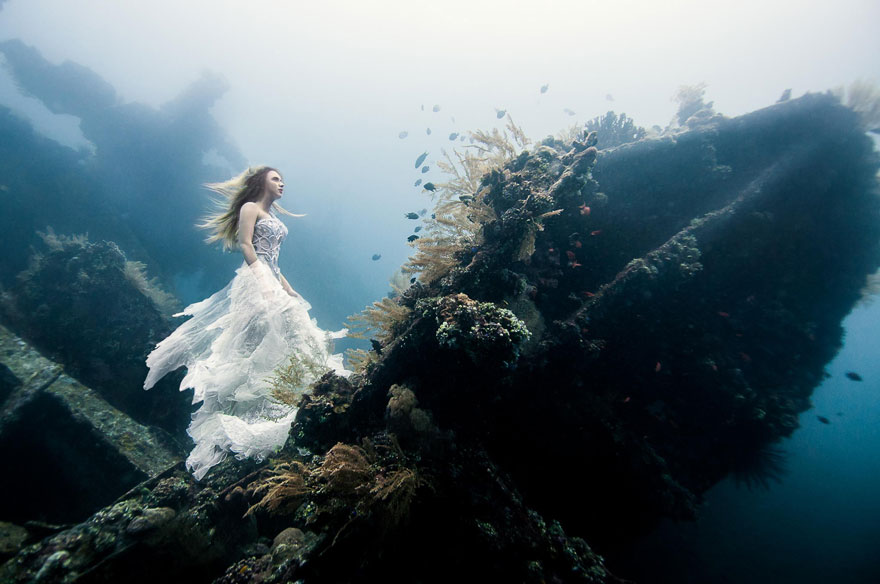
In the example shown above (image credit, naturally, goes to Benjamin Von Wong), one of his most recent photoshoots took place at a long-abandoned shipwreck off the coast of Bali, Indonesia - entirely underwater. It took an enormous crew of divers and models to pull off, and the photographs they produced were absolutely breathtaking. Because the models couldn't be festooned with scuba gear and the shipwreck was in fairly deep water, the solution presented itself in the form of freedivers. Freediving is the apparently exhilarating sport of extreme depth diving without any equipment, making them perfect candidates for models in great shape with the ability to hold their breath for extended periods in shark-infested waters, a remarkably specific set of requirements for a photoshoot.
Interestingly, Von Wong originally got his photographic start in Montreal, Canada, but after building a fan base on Facebook and Twitter, he was able to gather some Kickstarter funding to send him on a photographic odyssey throughout Europe. This should help give those of you aspiring to an artistic career the real value of social media, as the fanbase he established there allowed him to quit his day job and devote himself to photography fulltime.
He also was very careful in his use of the stories behind his shots, creating hit 'making of' videos that were released on YouTube to widespread interest. Due to the elaborate care that he takes in each and every step of his photoshoots, he was set to capitalize on the interest that art viewers always seem to express in the stories behind the images they enjoy.
As he explained to Digital Photography Review when asked how he built his fan-base, he said, "The same way that you come up with fans on any network, you just stay very active. I was shooting a lot. I was putting up almost a photograph a day." Social media can be a powerful tool, but it has to be used in the right way: regularly!
Posted on May 30th 2014 on 10:06pm
0 Comments
Tuesday 27th May 2014How the Art World Creates Value
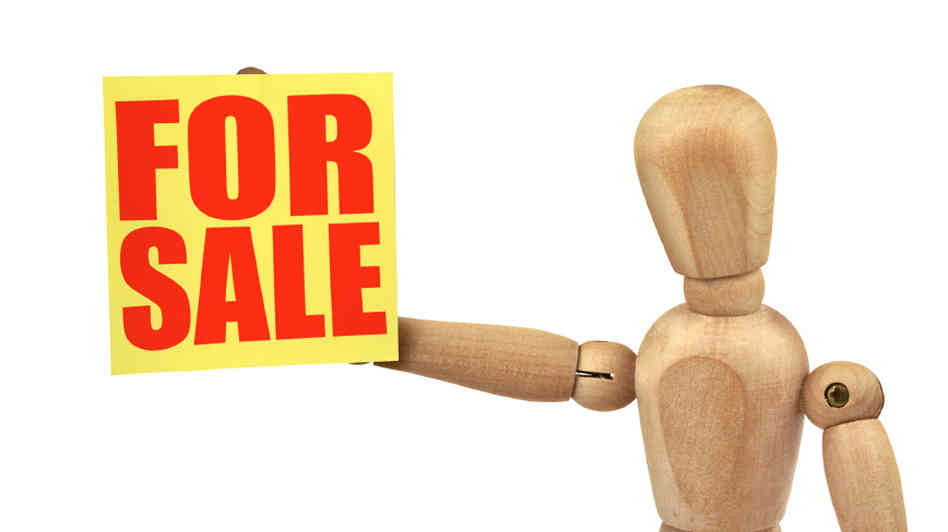
The value of art is a funny thing. The value of anything is determined by any number of factors, naturally, but as we saw with the advent of impressionist painting, value is no longer inherently about the technical skills employed in accurately representing the world around us. As in almost all other areas of the world, the art community establishes value based on a fairly random set of criteria. As we've seen lately, many of the world's most famous works command incredibly high prices, regardless of whether or not you accept the premise that the art world is experiencing a sales bubble.
Philip Hook, a leading art expert and a senior director at Sotheby's auction house, has put his finger on a number of circumstances that help create the seemingly-inflated prices that these works command. Interestingly, the majority of them tend to be related to the story behind the work itself, rather than specifically about the content or style. As we've discussed in previous posts, you can take advantage of this with some judicious self-promotion. By sharing the narrative of your artistic life, and how that intersects with and influences the rest of your life, can create a much more interesting story than the work would in a vacuum.
Consider Van Gogh: a world-renowned painter whose works command incredible prices at auction houses during the rare changes of ownership they see every few decades. But without the famous story of his anguish over his art, his depression, the self-mutilation of his ear and his eventual tragic suicide, would his work still command the respect and admiration that it does today? Perhaps, but there were a number of other artists whose work could easily be the ones revered in galleries throughout the world instead of Van Gogh.
This is not to say that you should be willing to hurt yourself or do anything permanently drastic just to make your art potentially valuable, but being aware of the power of narrative to shape the value of your work (both fiscally and perceptually) can be a very helpful tool in your artistic career. Many beginning artists are paradoxically shy about sharing the more intimate details of their lives, despite being inherently invested in expressive tendencies, and the sooner you can shake this habit, the sooner you'll be able to start taking advantage of your own ability to create works of value.
Posted on May 27th 2014 on 10:03pm
0 Comments
Friday 23rd May 2014Mac or PC for Your Digital Art?
One of the bitterest rivalries that has consumed generations of digital artists is the divide between the Mac and the PC. Okay, that might be a touch hyperbolic, as they haven't existed in their present incarnations for more than a generation, but there are still bitter feuds and harsh words exchanged between the two opposing camps. When the time comes to buy yourself a new computer, it's an important decision to make. Switching between the two can be something of a hassle, but it's not impossible, although as long as Adobe and other software makers are unwilling to allow their customers to switch platforms without purchasing additional copies of programs, that can be a major added expense when it comes to switching environments.
That being said, Macs have a long tradition of being used by the more creative types of personalities (although how much of that tendency is really justified and how much of it comes from Apple's exceptional marketing capabilities is really up for debate). In the hazy days of yore when even the most basic computer cost thousands of dollars, there was a real advantage for artists to use Macs. They paid closer attention to design, displayed colours more accurately than PCs of the day, and worked easily with Postscript printers.
Those days are past - long past, in fact. At this particular moment, 95% of the internal components of Macs are exactly the same as they are in PCs, and PCs tend to be capable of running anything that a Mac can with equal facility. Adobe has improved the PC versions of their products (Photoshop, Illustrator, and InDesign, among many others) to be completely on par with the Mac versions, and PC monitors now offer exactly the same colour fidelity that Mac screens do.
The next major concern, of course, is price. We artists tend not to be rolling in cash, although we are also very conscious of image (even though we often pretend not to be). This tends to make us lean towards Macs anyways, simply because they have a cachet that PCs don't, but when you're on a budget, 9 times out of 10 you can get a PC that will run circles around a Mac at a similar price - not to mention that the cheapest Macs available tend to approach the $1000 price point, while a perfectly serviceable PC can be had for half that price.
Naturally, there are some caveats, but at this point, the long-fought battle between the two can be said to be little more than marketing hype. Ultimately, it all comes down to what you're most comfortable with, as 99% of your digital artwork will be completed equally well on either platform. If you're into high-end video editing, you may be better off with a Mac, whereas if your emphasis is on 3D rendering, you may be better off with a PC. It all comes down to what you need, not which is better.
Posted on May 23rd 2014 on 07:13pm
0 Comments
Wednesday 21st May 2014How Far is Too Far?

Almost inherently, art is about reactions. Whether it's the hint of the sublime you feel from viewing the works of an old master, the shiver of creeping horror you feel from photo essays on wars, or the button pushing jokes of performance artists, it's all designed to provoke some type of reaction from the viewer. This reaction can have various goals, of course, but it seems almost inevitable that it has one - even if the goal isn't found within the work itself, as in the case of so many contemporary projects that emphasise the variations of response that individual interpretations can create, it can be found in the exploration of said interpretations. Art asks us to think. When heading down the long road towards overcoming the reactions of the jaded art world and reaching through into the mainstream consciousness, how far is too far?
The question grows ever more relevant in a world that is so bombarded with messages, both artistic and advertised, politically, spiritually, and economically, that artists are stepping up their game in order to make waves. Take the case of Alexander Selvik Wengshoel, a Norwegian artists who recently made headlines with a uniquely disturbing project he submitted for his graduate exhibition from art school. Recent art school graduates are notorious for ridiculously idiotic and asinine exhibits, but Wengshoel's project falls more on the disturbing side of the line.
Born with a deformed hip that many surgeries failed to correct, he finally underwent a surgery that changed everything, and replaced his hip with a metal prosthetic that enabled him to leave his wheelchair and crutches behind. It also left him with a piece of his own hip, which he took home from the hospital. After a (remarkably small) bit of careful deliberation, he ate the meat from his hip, and submitted the bone as his graduate exhibit. Yes, you read that correctly.
So we come back to the question of, 'How far is too far?' Wengshoel's rationale for the project is to explore the boundaries of personal space and what we can do with our own bodies, but this writer is a little suspicious of the seemingly -- if you'll pardon the expression -- unfleshed-out themes and explanation. He certainly grabbed headlines around the world, but did he go too far? Or is the simple fact that his submission is making us ask these questions enough of a justification for it in and of itself?
Posted on May 21st 2014 on 02:55pm
0 Comments
Friday 16th May 2014Artist Spotlight: Mark Flood
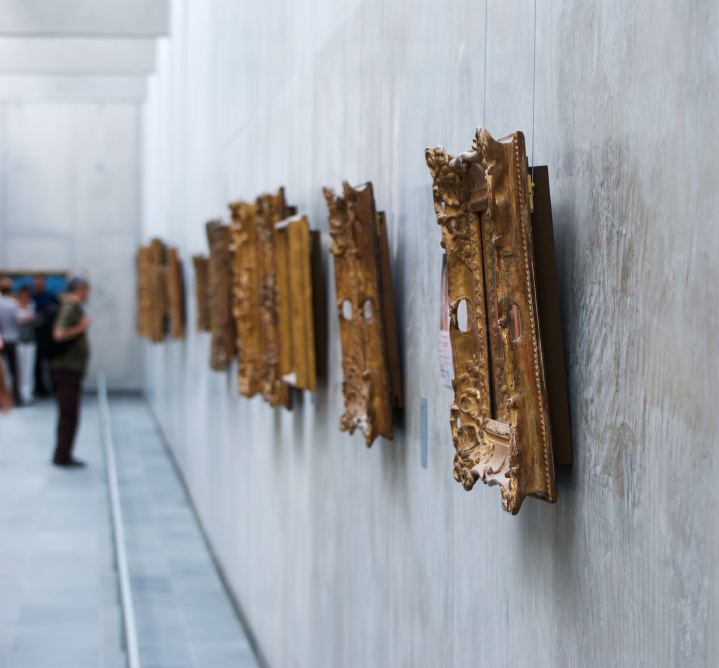
Contemporary art pulls us in a lot of directions at once. The sheer number of artists working in the world at any given time is pretty impressive, which means it takes a great deal of either luck, skill, persistence or a blend of all three to make sure your signal cuts through the noise. This series is dedicated to helping bring to light artists both artists that are doing exciting, remarkable, or ridiculous things to light, and those who haven't yet reached critical media mass.
Mark Flood has been an active artist for quite a long time, yet he was only brought to our attention last week due to his recent project in New York City, which he has dubbed the Insider Art Fair. As those of you who are relatively familiar with the art world are likely to know, so-called 'outsider art' refers to art created by those artists who are working outside of modern Western mainstream contemporary art (often code for post-colonial artists, those who are dealing with themes outside of the scope of most artists work, and others who appeal to the irritatingly jaded palates of said Western art world). Insider art, by extension, is from an artist working from within the very depths of contemporary Western art and all the history that implies.
Flood's "art fair" is really an exhibition, but one that not only provides interesting pieces derived from the world and sensibilities that informed the development of his style, but also as an indictment of the entire concept of art fairs, where the general attitude is to sell as much as possible as quickly as possible. The pieces tend to be caustic send-ups of both the art world and the corporate influences that have infected much of American art over the last several decades, and Flood appears unashamed and unapologetic, although as with an joke, it can sometimes be hard to tell who it's being played on.
When interviewed by the Gallerist at the Insider Art Fair, he said, "All the roles are breaking down. The collectors are curators, the museums are auction houses. I went to Frieze. I don’t have any problems with art fairs. For me, the fundamental issue as an artist at a fair is you don’t get to control the context of the work. Artists will have to take control, like always."
Here's hoping he can pull it off - or maybe the joke's on us.
Posted on May 16th 2014 on 02:36pm
0 Comments
Tuesday 13th May 2014Art al Fresco
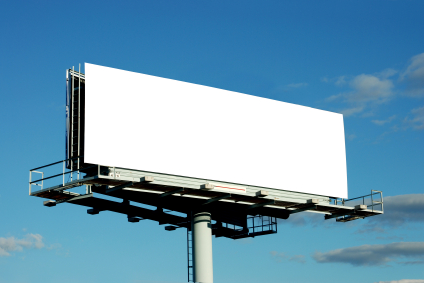
There is a disappointing trend emerging in the American cultural world. Perhaps not surprising in concept, but the numbers are a bit unnerving: only 21% of American adults have visited a gallery or museum in the past year, but over 80% have visited a fast food restaurant over the course of the previous week (though no word as yet about whether or not there is a correlation between the two ;-) ). While it may be easy to decry the loss of American culture, ditching the Whistler for Honey Boo Boo, a project has sprung up in America that seeks to bring artwork by famous American artists back to the forefront of the American landscape, both culturally and literally.
Based off a successful project that took place in the United Kingdom in 2013, the American version is titled 'Art Everywhere US', and aims to place works by prominent American artists on billboards across the nation. The British project replaced 22,000 billboards around the UK with works by British artists, and the American version is ready to top that this summer, with what will be the world's largest outdoor art exhibition, with over 50,000 billboards converted into artistic masterpieces.
Five museums are participating in the project to help raise awareness: LACMA, the Whitney Museum of American Art, the Art Institute of Chicago, the Dallas Museum of Art, and the National Gallery of Art have each put forward 20 pieces from their collection for consideration. An online voting poll will determine a final 50 pieces that will be placed all around the country.
"I think part of the idea behind the whole project is to put art in unexpected places and encourage those double-takes," says the CCO of the Whitney Museum of American Art, Jeff Levine, in an interview with Fast Company. "I have this image of driving on Route 66 in a convertible and seeing a Georgia O’Keefe billboard,” he adds. “I think for some of these artists whose work is actually geographically specific, some of the possibilities are really incredible."
Hopefully, it will spur increased interest in the arts, although it's hard to say if the downswing in gallery attendance really marks a decline in interest in art itself, or simply a decline in the interest of visiting a gallery. In an age of choice, the notion of curated content can be a bit off-putting to some, especially those art enthusiasts in younger demographics.
Posted on May 13th 2014 on 08:11pm
0 Comments
 The art world is famous for price tags as lofty as the masterpieces they represent. Staggering prices are commanded every time a famous work changes hands, and even the members of the public who aren't the target market are fascinated by the eye-popping sums. In the past, however, this type of big ticket sale has always been the province of the auction house; the Sotheby's, the Christie's, and occasionally a private sale brokered by a top-tier gallery. However, at the latest art fair in Basel (which we discussed previously in our post about the best cities for art lovers), an incredible challenge to the supremacy of the auction house has appeared.
The art world is famous for price tags as lofty as the masterpieces they represent. Staggering prices are commanded every time a famous work changes hands, and even the members of the public who aren't the target market are fascinated by the eye-popping sums. In the past, however, this type of big ticket sale has always been the province of the auction house; the Sotheby's, the Christie's, and occasionally a private sale brokered by a top-tier gallery. However, at the latest art fair in Basel (which we discussed previously in our post about the best cities for art lovers), an incredible challenge to the supremacy of the auction house has appeared. If there's one thing I've learned over the course of my artistic career, it's that art doesn't happen in a vacuum. That's not to say that art can't happen in space - Commander Hadfield's rendition of David Bowie's Space Oddity on the International Space Station leaps to mind - but rather that the kind of ideas and inspiration that drive your creativity and artistic thinking don't happen in a vacuum. In order to function at your full creative potential, you need a great deal of new input, whether it's new ideas that you've gotten from casual conversations with friends or a new exhibit that inspired you to test out some new techniques or anything in between. Exposure to the world is what makes us want to create.
If there's one thing I've learned over the course of my artistic career, it's that art doesn't happen in a vacuum. That's not to say that art can't happen in space - Commander Hadfield's rendition of David Bowie's Space Oddity on the International Space Station leaps to mind - but rather that the kind of ideas and inspiration that drive your creativity and artistic thinking don't happen in a vacuum. In order to function at your full creative potential, you need a great deal of new input, whether it's new ideas that you've gotten from casual conversations with friends or a new exhibit that inspired you to test out some new techniques or anything in between. Exposure to the world is what makes us want to create. Unless you've been living on the Moon for the last few years, you've probably run across the term 'crowdfunding'. If you haven't heard of it before, the concept is actually extremely simple, albeit incredibly powerful. It uses a 'pay-what-you-can' model distributed over a large number of potential customers to acquire funding for projects. There are often various tiers of contributors, so that those who contribute more to a project get more out of it than those who make the minimum contribution.
Unless you've been living on the Moon for the last few years, you've probably run across the term 'crowdfunding'. If you haven't heard of it before, the concept is actually extremely simple, albeit incredibly powerful. It uses a 'pay-what-you-can' model distributed over a large number of potential customers to acquire funding for projects. There are often various tiers of contributors, so that those who contribute more to a project get more out of it than those who make the minimum contribution. If you're a painter, you might have been here before: you're working on a canvas, nearly finished executing your vision, and suddenly you get frustrated and decide to scrap the project. Or maybe you've suddenly come up with a brilliant painting but you're all out of prepped canvases, and you need to start work immediately to preserve the clarity of your idea. Whatever the reason, the only way to get yourself a new working space is to paint over something you've already done. It's probably happened to you at least once in your artistic career, and if not, then you should consider yourself lucky! But what happens when you turn out to be one of the most famous painters of the previous century? Gallery and museums will bring out the forensic toolkit!
If you're a painter, you might have been here before: you're working on a canvas, nearly finished executing your vision, and suddenly you get frustrated and decide to scrap the project. Or maybe you've suddenly come up with a brilliant painting but you're all out of prepped canvases, and you need to start work immediately to preserve the clarity of your idea. Whatever the reason, the only way to get yourself a new working space is to paint over something you've already done. It's probably happened to you at least once in your artistic career, and if not, then you should consider yourself lucky! But what happens when you turn out to be one of the most famous painters of the previous century? Gallery and museums will bring out the forensic toolkit!
 The value of art is a funny thing. The value of anything is determined by any number of factors, naturally, but as we saw with the advent of impressionist painting, value is no longer inherently about the technical skills employed in accurately representing the world around us. As in almost all other areas of the world, the art community establishes value based on a fairly random set of criteria. As we've seen lately, many of the world's most famous works command incredibly high prices, regardless of whether or not you accept the premise that the art world is experiencing a sales bubble.
The value of art is a funny thing. The value of anything is determined by any number of factors, naturally, but as we saw with the advent of impressionist painting, value is no longer inherently about the technical skills employed in accurately representing the world around us. As in almost all other areas of the world, the art community establishes value based on a fairly random set of criteria. As we've seen lately, many of the world's most famous works command incredibly high prices, regardless of whether or not you accept the premise that the art world is experiencing a sales bubble. One of the bitterest rivalries that has consumed generations of digital artists is the divide between the Mac and the PC. Okay, that might be a touch hyperbolic, as they haven't existed in their present incarnations for more than a generation, but there are still bitter feuds and harsh words exchanged between the two opposing camps. When the time comes to buy yourself a new computer, it's an important decision to make. Switching between the two can be something of a hassle, but it's not impossible, although as long as Adobe and other software makers are unwilling to allow their customers to switch platforms without purchasing additional copies of programs, that can be a major added expense when it comes to switching environments.
One of the bitterest rivalries that has consumed generations of digital artists is the divide between the Mac and the PC. Okay, that might be a touch hyperbolic, as they haven't existed in their present incarnations for more than a generation, but there are still bitter feuds and harsh words exchanged between the two opposing camps. When the time comes to buy yourself a new computer, it's an important decision to make. Switching between the two can be something of a hassle, but it's not impossible, although as long as Adobe and other software makers are unwilling to allow their customers to switch platforms without purchasing additional copies of programs, that can be a major added expense when it comes to switching environments. Almost inherently, art is about reactions. Whether it's the hint of the sublime you feel from viewing the works of an old master, the shiver of creeping horror you feel from photo essays on wars, or the button pushing jokes of performance artists, it's all designed to provoke some type of reaction from the viewer. This reaction can have various goals, of course, but it seems almost inevitable that it has one - even if the goal isn't found within the work itself, as in the case of so many contemporary projects that emphasise the variations of response that individual interpretations can create, it can be found in the exploration of said interpretations. Art asks us to think. When heading down the long road towards overcoming the reactions of the jaded art world and reaching through into the mainstream consciousness, how far is too far?
Almost inherently, art is about reactions. Whether it's the hint of the sublime you feel from viewing the works of an old master, the shiver of creeping horror you feel from photo essays on wars, or the button pushing jokes of performance artists, it's all designed to provoke some type of reaction from the viewer. This reaction can have various goals, of course, but it seems almost inevitable that it has one - even if the goal isn't found within the work itself, as in the case of so many contemporary projects that emphasise the variations of response that individual interpretations can create, it can be found in the exploration of said interpretations. Art asks us to think. When heading down the long road towards overcoming the reactions of the jaded art world and reaching through into the mainstream consciousness, how far is too far? Contemporary art pulls us in a lot of directions at once. The sheer number of artists working in the world at any given time is pretty impressive, which means it takes a great deal of either luck, skill, persistence or a blend of all three to make sure your signal cuts through the noise. This series is dedicated to helping bring to light artists both artists that are doing exciting, remarkable, or ridiculous things to light, and those who haven't yet reached critical media mass.
Contemporary art pulls us in a lot of directions at once. The sheer number of artists working in the world at any given time is pretty impressive, which means it takes a great deal of either luck, skill, persistence or a blend of all three to make sure your signal cuts through the noise. This series is dedicated to helping bring to light artists both artists that are doing exciting, remarkable, or ridiculous things to light, and those who haven't yet reached critical media mass. There is a disappointing trend emerging in the American cultural world. Perhaps not surprising in concept, but the numbers are a bit unnerving: only 21% of American adults have visited a gallery or museum in the past year, but over 80% have visited a fast food restaurant over the course of the previous week (though no word as yet about whether or not there is a correlation between the two ;-) ). While it may be easy to decry the loss of American culture, ditching the Whistler for Honey Boo Boo, a project has sprung up in America that seeks to bring artwork by famous American artists back to the forefront of the American landscape, both culturally and literally.
There is a disappointing trend emerging in the American cultural world. Perhaps not surprising in concept, but the numbers are a bit unnerving: only 21% of American adults have visited a gallery or museum in the past year, but over 80% have visited a fast food restaurant over the course of the previous week (though no word as yet about whether or not there is a correlation between the two ;-) ). While it may be easy to decry the loss of American culture, ditching the Whistler for Honey Boo Boo, a project has sprung up in America that seeks to bring artwork by famous American artists back to the forefront of the American landscape, both culturally and literally.



